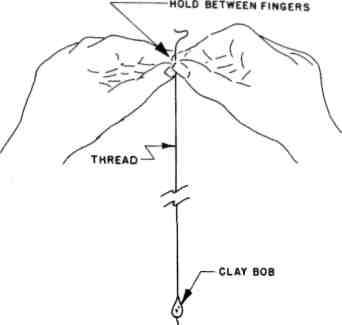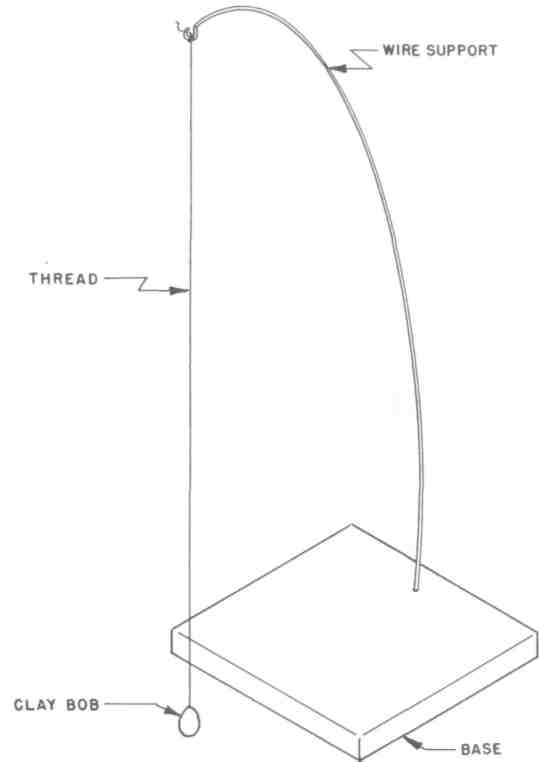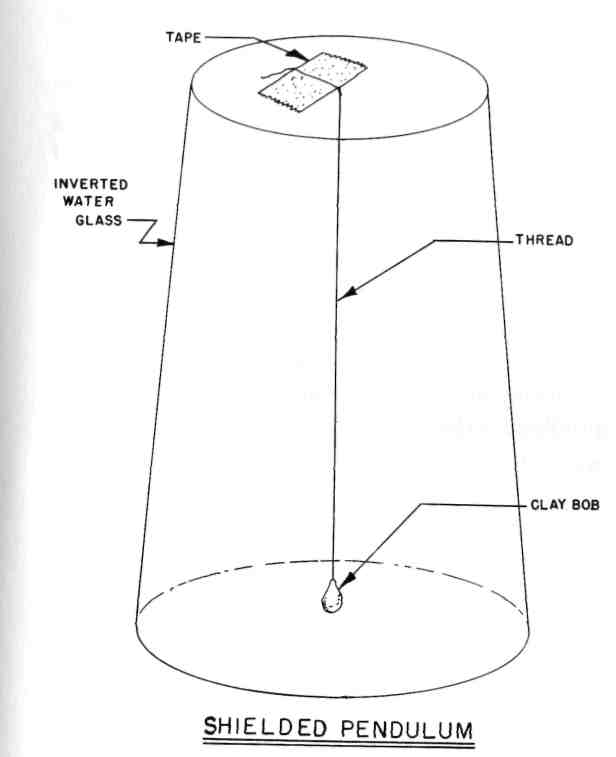
- •11701 South Belcher Road, Suite 123
- •Introduction
- •Introduction
- •Chapter one
- •Chapter two detector rods Basic Description:
- •Chapter three
- •Chapter four the energy wheel Basic Description:
- •Chapter five pendulums Basic Description:
- •Inside an inverted water tumbler as shown.
- •Chapter six
- •Basic Description:
- •Chapter seven
- •Chapter eight
- •Basic Description:
- •Integrated circuit amplifier board for the
- •Chapter nine
- •Chapter ten postscript
- •Bibliography
- •11701 South Belcher Road, #123
Chapter five pendulums Basic Description:
In some respects, the two different pendulum types described in this chapter are similar in operation to the energy wheel of the previous chapter. Both consist of very light masses suspended from supports by thin threads . It is claimed that the action of volitional thought can cause the pendulum to move. In the case of the pendu-
83
Mind Machines You Can Build
lum, however, it appears to offer "yes-no" answers to questions. It also appears that it can be used to indicate the direction to a wanted object.
The first type of pendulum is hand-supported. It is undoubtedly the easiest to operate. However, the possibility of minute, subconscious movements on the part of the operator casts considerable doubt on any claim that a hand-supported pendulum is a "amazing mind machine" operating because of as yet unknown operational principles.
The second type of pendulum is supported from a rigid point such as a lampshade edge, desk lamp, or simple tripod support made from wooden dowels. The independently-supported pendulum eliminates the possibility that the human operator could control its swing by unconscious and minute finger, hand, and/or arm movements. The independently-supported pendulum may also be operated under a transparent cover to eliminate the possibility that air currents might affect its swing.
The operator "thinks" or concentrates on the pendulum, asking a question that can be answered in a "yes-no" manner. By previous agreement, the swing of the pendulum to and away from the operator may mean "yes" while a swing from left to right may mean "no." The operator must announce prior to the start of the experiment which direction of motion signifies affirmative and which indicates the negative response.
84
Pendulums
To use the pendulum as a locator similar to detector rods, the operator asks the pendulum to swing in the direction of the object whose location is being sought. There is, of course, an ambiguity in the fact that the unknown object can be located in either direction that the pendulum swings - i.e., if the pendulum swings in a north-south plane, the object could be located either north or south of the operator. Some operators appear to be extremely adept in getting the pendulum to swing in a most unusual fashion when in the locator mode: they can cause the pendulum to swing from its vertical rest position to a displaced position in the direction of the object, then cause the pendulum to swing between the vertical rest position and the displaced position.
Historical Background:
"The Magic Pendulum" has its origins lost in the mists of prehistory. It has long been a device used by wizards and shamins. Just because a device has a long history doesn't mean that we, with our immensely increased wisdom growing from a centuries-old legacy of scientific progress, should both scoff at and ridicule such devices that appear to have no rational explanation in terms of the Universe as we know and believe it to be. All our ancestors for several hundred thousand years not only believed in such "magic" devices but conducted their affairs in accordance with what these devices told
85
Mind Machines You Can Build
them. We know beyond the shadow of a doubt that their reliance on these devices could not have been foolish and/or disastrous because our ancestors lived and thrived and produced progeny culminating in ourselves. If all our ancestors were fools and we of the modern "scientific" age are so smart, this would mean that the Mende-lian Laws of genetics and heredity are plainly nonsense. But we also know for a fact that these principles of biotechnology are indeed valid, true, and (most important) pragmatically workable. Ask any breeder of horses or dogs or any farmer who relies on hybridized crops. Perhaps our forebears were not quite the stupid clods we tend to believe, but possessed some evidence that strange machines such as the pendulum did indeed have some validity, even though they didn't understand why they worked and therefore placed them in the "magic" classification.
Human beings are also eminently practical. If it doesn't work, it's discarded. If it seems to work most of the time or enough of the time to make it useful, it's used until something better is discovered or developed.
Very little research work or further development has been undertaken with this extremely simple machine. It exists today in nearly the same form as it has for uncounted centuries.
However, the social milieu has changed. In most of the world today, you will not be burned at the stake as a witch for experimenting with such devices as the
86
Pendulums
Figure 5-1: Hand-supported pendulum. Rest your elbows on a table to steady your hands.
pendulum. (However, there are still some locales in the United States where you would be well advised to be somewhat circumspect in such experimentation simply because America has all types of people in it, including those who are still very superstitious, fearful, and violent.)
Author's Experiences:
I do not remember when I first tried using a pendulum. It may have been when I was about twelve or thirteen years old and became fascinated by a ouija board, which led me to experiment with some of the other
87
Mind Machines You Can Build
devices of "witchcraft and sorcery" that my juvenile colleagues brought forth from time to time. Many of these machines were "discovered" and subsequently experimented with because we were at that age and that level of scholastic sophistication where we were being introduced to the Scientific Method and to the mysteries of the Universe revealed by our resident scholastic magician, the junior high school science teacher, one Donald John Obee at Cheyenne Mountain School in Colorado Springs, Colorado. One thing I can say for Mr. Obee: He made science and technology fascinating, fun, and also frustrating enough to encourage me out of curiosity to continue to be interested in science and technology for the rest of my life. The mere idea that I didn't have to be captive to the whims of nature but could, if I understood enough about it, manipulate the Universe so that I could do magic things like fly in the air and go to the moon got me hooked at an early age because, even then, I felt I had been jerked around enough by a capricious Universe. I can make a hand-supported pendulum work. But I don't always know whether or not it gives me the correct "yes-no" answers because I haven't used it enough for that purpose. The pendulum requires that the operator play the game of "Twenty Questions. Doing this often takes longer to answer a question than to either go look it up in a suitable reference book or think it through and work it out myself. And I've never really been certain that I wasn't unconsciously making the pendulum swing
88
Pendulums
the way I wanted it to swing. I often have much the same feeling about detector rods but in the case of that device, there is absolutely no question in my mind that I am not making those rods swing for the simple reason that the response is so strong.
I can also make a self-supported, glass-enclosed pendulum swing. I don't know why, although, as you will see later, I do indeed have a hypothesis.
Observations of other people operating pendulums of both sorts shows that about 80% of volunteer subjects can make a hand-supported pendulum do something while about 50% of people can make the self-supported pendulum operate. I don't know why.
Instructions for Fabrication:
This is one of the simplest of all mind machines to build and operate.
The following materials are required:
A thumb tack, paper clip, or a minute pinch of plasticene modelling clay to use as a pendulum bob.
A spool of sewing thread for the pendulum itself; this can be made of nylon, silk, polyester, or any other material.
Cellophane tape to use for affixing the upper end of the pendulum to a support.
89
Mind Machines You Can Build
4. A pendulum support; this can be nothing more sophisticated than the shade of a desk lamp, study lamp, or table lamp; or the lower edge of a kitchen or bathroom cabinet.
5. A glass water tumbler and a polystyrene plastic water tumbler (this last item optional).
Cut an eighteen-inch length of thread (longer if your pendulum support is higher than this distance from the table or other horizontal surface; in fact, the longer the pendulum, the more sensitive it will be).
Tie one end of the thread to the pendulum bob - the paper clip or thumb tack - or mold a bean-sized lump of plasticene modelling clay around the end of the thread.
No further fabrication is required for the hand-supported pendulum.
An independently-supported pendulum can be made by taping the free end to the lamp shade so that the pendulum bob swings freely just above the surface of a table.
The pendulum can also be fabricated inside the water tumbler by taping the free end of the pendulum support to the inside of the bottom of the glass so that the pendulum bob swings freely inside the tumbler when it is inverted. For a pendulum that's more sensitive, use one of those tall conical beer glasses.
90
Pendulums
Figure 5-2: An independently-supported pendulum.
Any method of supporting the pendulum will work.
The longer the pendulum, the more sensitive the
pendulum will be.
91
Mind Machines You Can Build
Serious investigators may wish to fabricate a series of pendulums having bobs of differing sizes, weights, shapes, and densities; supports made from various thicknesses of thread and thread materials; and enclosures consisting of cylindrical glass and lucite plastic tubes with suitable supports or caps on their upper ends from which to suspend the pendulum.
But the common, parlor-variety pendulum for "quick-and-dirty" empirical experiments can be made in satisfactory form with the very simple materials detailed above.
Operating Instructions: Hand-supported pendulum:
Seat yourself in a comfortable chair at a table in a location free of air currents from air conditioners, heaters, fans, and drafts from open windows. Take the free end of the pendulum support thread between the fingers of your hand, and place both hands together to steady one another. (Fig. 5-1) Place your elbows on the surface of the table to steady them. Adjust the length of the pendulum until the bob swings just clear of the table top. Determine the direction of the pendulum swing in yes-no response to your questions. It is normal in most
92
Pendulums
European cultures for the "yes" response to be a swing toward and away from the body of the operator while a "no" response is a side-to-side, left-right swing.
Determine what you wish to know. The questions must be phrased so that they can be answered as "yes" or "no." This often means framing a series of questions to arrive at the desired answer. People who are experienced at playing "Twenty Questions" will find it easier than someone who is not.
Most people will get a pendulum response when it is operated in this hand-supported mode.
Independent suspension mode:
Affix the free end of the pendulum thread with cellophane tape to an overhanging support (Fig. 5-2) such as a lamp shade or shelf in a location reasonably free of air currents from air conditioners, fans, heaters, and drafts from open windows. Adjust the pendulum length so that the pendulum bob swings freely just above the surface of the table or counter. Seat yourself comfortably in front of the pendulum. With your hands, still the swing of the pendulum that may have been produced in the act of suspending it. Once the pendulum is hanging quietly, place your arms on the table and cup your hands
93
Mind Machines You Can Build
around the pendulum bob about three to six inches away from it. Novices may discover that it is easier to work the pendulum with their hands cupped closer to it.
Operate the pendulum as described for the hand-supported unit. Frame and ask your questions in the same manner.
Experiments:
If the hand-supported pendulum experiment works for you, try the independently suspended pendulum.
Once you have obtained results from the independently-suspended pendulum, try making it swing without cupping your hands around the pendulum bob.
As in the experiments with the energy wheel in the previous chapter, try coating your palms with a thin film of baby or bath oil to change the electrical characteristics and dielectric constant of your skin. Or wash your hands thoroughly and completely to remove as much natural skin oil as possible.
If you suspect that air currents from your breath, someone else's breath, or ambient air currents in the room are the cause of pendulum action, perform the enclosed pendulum experiment by suspending the pendulum inside an inverted glass water tumbler. (Fig. 5-3) Cup your hands around the outside of the tumbler and repeat the basic operating instructions given above.
94
Pendulums
Figure 5-3: To eliminate any possibility of air
currents swinging the pendulum, mount it
95
